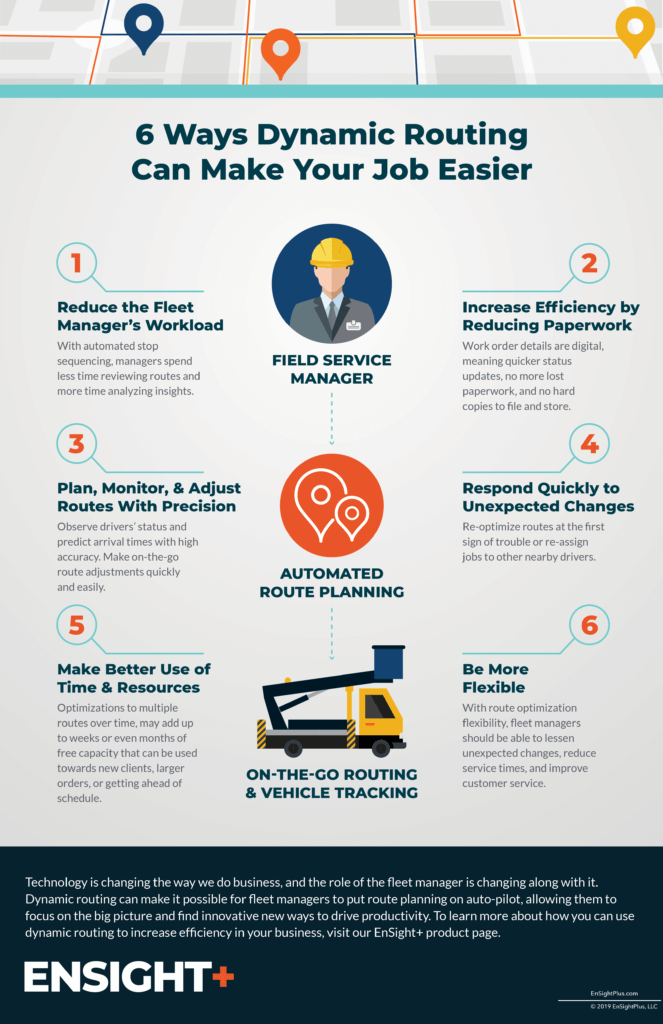
In the past, the only way for fleet managers to plan service routes was by manually plotting out destinations. Although it fails to account for variables like traffic, weather, and last-minute changes, static routing has been the status quo for many years. However, global positioning technology (GPS) has changed everything from the route we take to work to the way emergency responders respond to distress calls. GPS as we know it has been around for over 40 years, but it’s relatively recent that it’s become affordable and normalized within field operations.
As such, there is a new standard in field service routing, and fleet management best practices call for dynamic route planning, a flexible approach to devising routes.
As such, there is a new standard in field service routing, and fleet management best practices call for dynamic route planning, a flexible approach to devising routes. It uses GPS to calculate travel times and responds to traffic changes, service priorities, and other unforeseen events.
With this broad understanding of the applications of both static and dynamic routing, it’s time to explore how these fleet management tactics differ. Read on to determine whether your route planning operations have room for improvement.
Among the beneficial aspects of dynamic route planning software is automated sequencing. If stops aren’t sequenced efficiently, drivers may take longer to complete their route and productivity may suffer. Bringing on new clients located further away from your headquarters can compound these problems as travel times increase and drivers may struggle with unfamiliar areas.
In static routing, stop sequencing can be a time-consuming process performed manually by the fleet manager. But in business, anything that can be automated often should be. Fleet route planning is no exception. The automation of stop sequencing can be a benefit to fleet managers in particular, who can spend less time reviewing routes and more time focused on analyzing insights.
You’re risking documents getting lost or damaged if your business is still using paper-based work orders. Fleet managers may also have to spend extra time inputting that data into their system.
Route optimization software with work order management capabilities can make it possible for technicians to complete orders on their mobile devices. Work order details can be entirely digital and instantly logged into a central database. This can mean quicker status updates, no more losing paperwork, and no hard copies to file and store away.
A new standard of convenience can come with digital automation and fleet GPS software. Dynamic routing can make easy work of on-the-go route adjustments and can predict arrival times with high accuracy. This can mean more efficient drivers and better customer service.
Route planner software with vehicle tracking can also provide insight into whether a driver is falling behind schedule or is in danger of missing an important deadline. The fleet manager can observe drivers’ status and decide whether to notify the client or reroute another driver.
Unexpected problems can arise no matter how well a vehicle is maintained. A nail in the tire, a problem with the engine, or a collision can derail an entire workday. Dynamic routing software can’t prevent these hiccups, but it can be used to respond quickly and mitigate the effects.
A watchful fleet manager can re-optimize routes at the first sign of trouble or re-assign jobs to other nearby drivers. This helps ensure that customers receive the best possible service. He or she can also keep an eye on driver behaviors, like acceleration and braking, and address risky behavior before an accident occurs. Loss of productivity aside, keep in mind that car accidents can eat into profits in the form of property damages, medical care, legal costs, and rising insurance rates.
Most often, the only way a business can grow is with a surplus of resources or time. Fleet management software with route optimization can make better use of both, and the results can be dramatic.
For example, work requiring eight hours on a static route may only take five hours with dynamic routing. When you apply these optimizations to multiple routes over time, the savings are incredible. Use that extra time for new clients, larger orders, or getting ahead of schedule.
If drivers followed the same fixed routes every day, then static route planning may be sufficient. Because orders may fluctuate and accidents may happen, strict adherence to a pre-set route can be inefficient and wasteful. Traffic and order volumes vary, and customers have a much higher expectation of timeliness and accuracy.
Need a driver to make an urgent stop outside his or her route before the end of the day? A good fleet management software should have route optimization features that offer exceptional flexibility. With flexibility, fleet managers should be able to lessen unexpected changes, reduce service times, and improve customer service. If you’re still shopping around for the right fleet routing software, InboundLogistics.com provides comparison options.
Static route planning is an outdated technique that requires a lot of hands-on maintenance. Dynamic routing software is quickly becoming the new industry standard.
Technology is changing the way we do business, and the role of the fleet manager is changing along with it. Dynamic routing can make it possible for fleet managers to put route planning on auto-pilot. This allows them to focus on the big picture and drive productivity. To learn more about how you can use dynamic routing to increase efficiency in your business, visit our EnSight Plus product page.